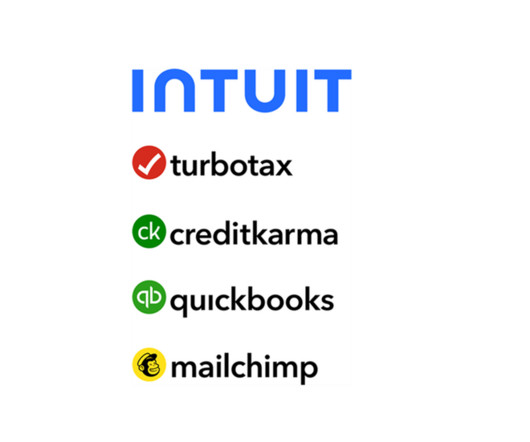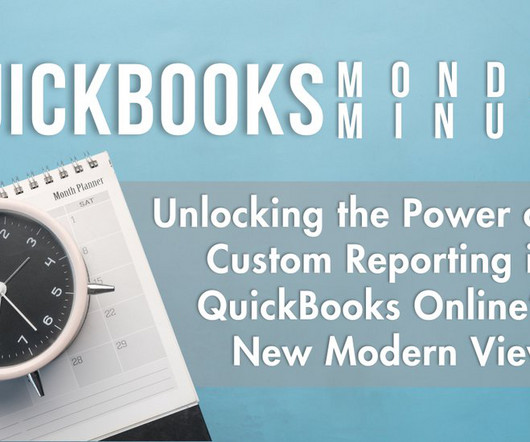Could YOU be the next Member of Ted Callahan's Team?
Insightful Accountant
APRIL 7, 2024
Ted Callahan, the Accountant Leader at Intuit, is looking for two (2) extraordinary leaders to join his team at Intuit. Are you one of them?

Insightful Accountant
APRIL 7, 2024
Ted Callahan, the Accountant Leader at Intuit, is looking for two (2) extraordinary leaders to join his team at Intuit. Are you one of them?

Accounting Tools
APRIL 7, 2024
What is Manufacturing Overhead? Manufacturing overhead is all indirect costs incurred during the production process. This overhead is applied to the units produced within a reporting period , so that the cost of these units are fully burdened with all manufacturing costs. These costs are then charged to the cost of goods sold as the units are sold over time.
This site is protected by reCAPTCHA and the Google Privacy Policy and Terms of Service apply.

Insightful Accountant
APRIL 7, 2024
The new Modern Reports have been out for over a year in QBO Advanced, and they offer substantially more powerful reporting capability than the Classic reports we’ve long been used to.

Accounting Tools
APRIL 7, 2024
What are Liabilities? Liabilities are legal obligations payable to a third party. A promise to make a payment on a future date is a liability. A liability is recorded in the general ledger , in a liability-type account that has a natural credit balance. A number of examples of liability accounts are presented in the following list, which is split into current and long-term liabilities: Examples of Current Liabilities The following are examples of current liabilities.

Speaker: Nancy Wu, Head of Sales and Customer Success at SkyStem
Join us for an enlightening webinar as we delve into the transformative realm of modern accounting practices. In today's digital age, the convergence of outsourcing and automation has revolutionized how businesses manage their financial operations. In this webinar we will explore the synergistic potential of these two strategies to streamline processes, enhance accuracy, save cost and drive strategic decision-making.

Insightful Accountant
APRIL 7, 2024
The Department of Treasury and the Internal Revenue Service today issued Announcement 2024-19 that addresses the federal income tax treatment of amounts paid for the purchase of energy-efficient property and improvements.

Counto
APRIL 7, 2024
Easy Guide to Converting Your Sole Proprietorship to a Private Limited Company Are you a sole proprietor and eyeing the transition to a Private Limited (Pte Ltd) company? This guide will walk you through the process, highlighting the advantages, essential steps, and key considerations for a smooth conversion. Let’s explore how this transformation can propel your business towards greater success and prosperity.
Financial Ops World brings together the best financial operations content from the widest variety of thought leaders.

Counto
APRIL 7, 2024
A Director’s Handbook to Paying Yourself As a sole company director, you hold the reins of your business, making critical decisions and managing your enterprise’s day-to-day operations. But when it comes to rewarding yourself for your hard work, navigating the realm of salary payments can be complex. In this guide, we’ll explore various methods and strategies for paying yourself as a sole director, ensuring both financial stability and tax efficiency.

Insightful Accountant
APRIL 7, 2024
For self-employed professionals, managing expenses is crucial for financial stability and long-term success.

Accounting Tools
APRIL 7, 2024
What is the Debt Service Coverage Ratio? The debt service coverage ratio measures whether a business has sufficient cash flow to pay its debt obligations. In essence, it compares cash flows to debt service payments. A positive debt service ratio indicates that an organization’s cash flows can cover all offsetting debt payments, while a negative ratio indicates that the business must contribute additional funds to pay for the annual loan payments.

Accounting Tools
APRIL 7, 2024
What are Issuance Costs? Issuance costs are those expenditures associated with underwriting and issuing debt securities and equity securities. Issuance costs include audit fees, investment banking fees, legal fees, marketing expenses, and Securities and Exchange Commission (SEC) registration fees. Issuance costs do not include any expenditures that must be made by a publicly-held company on an ongoing basis, such as control audits , annual financial statement audits , quarterly reviews , stock e

Speaker: Robbie Bhathal, Founder & CEO, and Matthew Acalin, Head of Credit Intelligence
In today's volatile financial environment, how confident are you in your company’s financial forecasting? To get the most accurate cash predictions that will lead to long-term financial survival, real-time data is critical. Innovative cash management strategies can lead to better credit opportunities, more sustainable growth, and long-term financial prosperity.

Accounting Tools
APRIL 7, 2024
What is the Internal Rate of Return? The internal rate of return (IRR) is used to calculate the projected profitability of a proposed investment. It is the rate of return at which the present value of a series of future cash flows equals the present value of all associated costs. A proposed investment with a high IRR is usually considered a desirable use of funds.

Accounting Tools
APRIL 7, 2024
Who are the External Users of Accounting Information? External users are those entities interested in the financial results of a business, but who take no part in operating the entity. Accounting standards are intended for this audience, so that organizations release financial statements that are consistently formulated across entire industries, making it easier for external users to rely upon the presented information.

Accounting Tools
APRIL 7, 2024
What is Intercompany Netting? Intercompany netting is the offsetting of accounts receivable and accounts payable between two business entities owned by the same parent. This means that payment is only made for the net difference between their receivables and payables, resulting in significantly lower cash flows between the parties. Intercompany netting is especially useful for international payments, since it identifies situations where a business can hedge the much smaller net amounts of foreig
Let's personalize your content